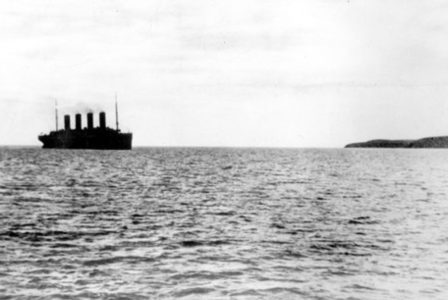RMS Titanic sank in the early morning of 15 April 1912 in the North Atlantic Ocean, four days into the ship's maiden voyage from Southampton to New York City.
Last photograph of the Titanic: The article’s supporting photo is of the Titanic departing Queenstown (Cobh), Ireland, today 1912 — never to be seen afloat again.
Titanic had an estimated 2,224 people on board when she struck an iceberg at around 23:40 (ship's time)[a] on Sunday, 14 April 1912. Her sinking two hours and forty minutes later at 02:20 (ship's time; 05:18 GMT) on Monday, 15 April, resulted in the deaths of more than 1,500 people, making it one of history's deadliest marine disasters during peacetime.
Titanic received six warnings of sea ice on 14 April but was travelling near her maximum speed when her lookouts sighted the iceberg. Unable to turn quickly enough, the ship suffered a glancing blow that buckled her starboard side and opened six of her sixteen compartments to the sea (the forepeak, all three holds, and boiler rooms 5 and 6). Titanic had been designed to stay afloat with four of her forward compartments flooded but no more, and the crew soon realised that the ship would sink. They used distress flares and radio (wireless) messages to attract help as the passengers were put into lifeboats. In accordance with existing practice, Titanic's lifeboat system was designed to ferry passengers to nearby rescue vessels, not to hold everyone on board simultaneously; therefore, with the ship sinking rapidly and help still hours away, there was no safe refuge for many of the passengers and crew. Compounding this, poor management of the evacuation meant many boats were launched before they were completely full.



